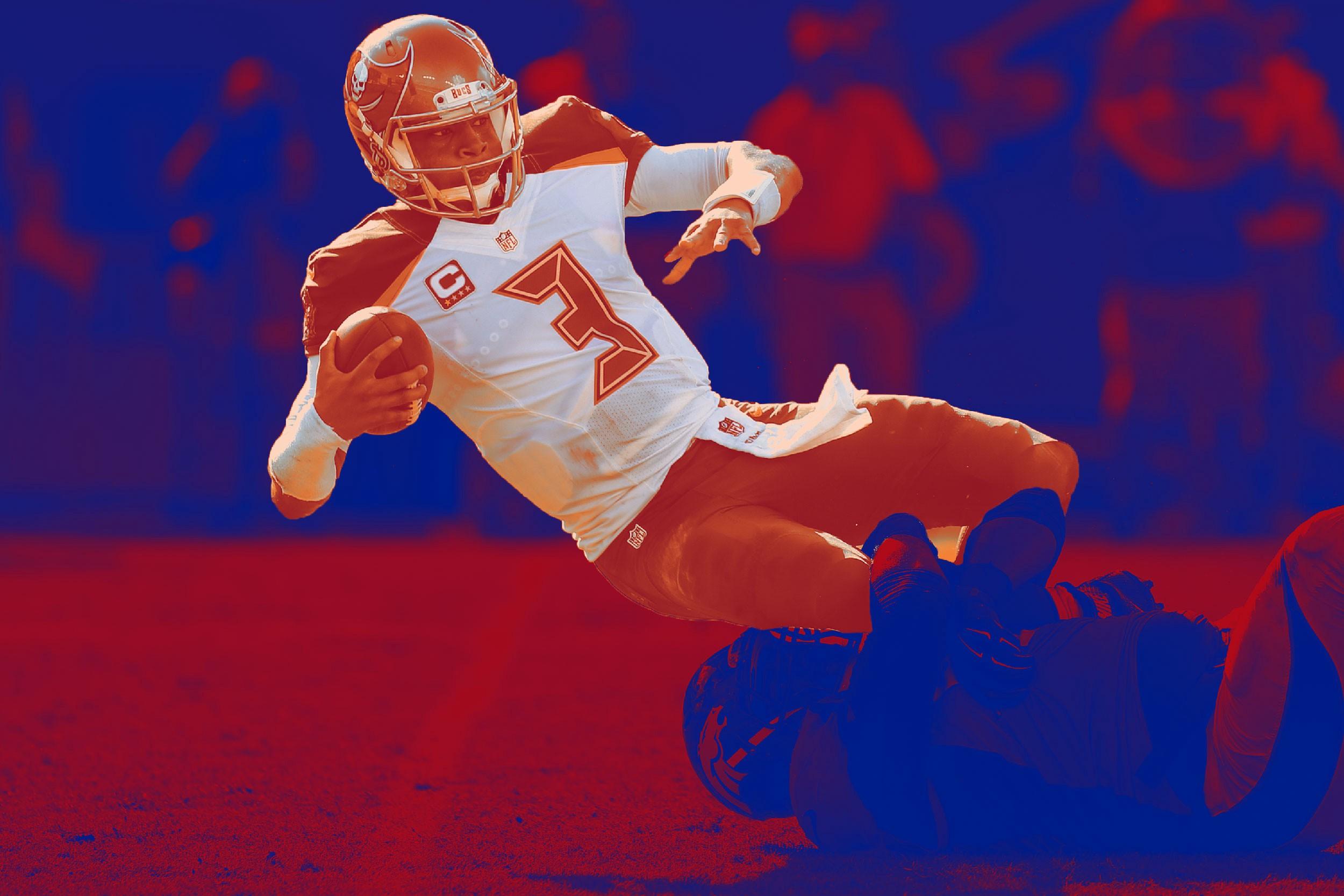Four games into Jameis Winston’s rookie season, the Buccaneers were 1–3 and the first-overall pick had turned the ball over eight times. Four games into his sophomore season, the Buccaneers are 1–3, and Winston has turned it over 10 times.
While Tampa Bay head coach Dirk Koetter said on Sunday that he was “very concerned” about his second-year signal-caller, he made a point to say that Winston, despite his struggles, is not regressing. But there’s no other way to say it: Going from eight turnovers to 10 is regression.
Now, not all of the turnovers this year have been Winston’s fault — other culprits include: tipped passes, bad routes by receivers, and poor protection by the offensive line — but Tampa Bay needs a Week 5 turnaround from its quarterback similar to the one it saw from him as a rookie. In his first four games in 2015, Winston threw seven interceptions and lost a fumble, but then went turnover-free over the next four games. Winston’s strong finish last year — a 12-game stretch in which he completed nearly 60 percent of his passes, with 16 touchdowns to just eight picks — foreshadowed a breakout season in 2016. At least it looked that way after the opening weekend: Winston threw four touchdowns in a victory over Atlanta. But he’s turned the ball over eight times in a three-game span, and the Bucs have lost three in a row.
Part of the problem is that Tampa Bay hasn’t done a good job of putting weapons around its franchise quarterback. Mike Evans is an elite talent, but past that, the investments on the offense haven’t panned out. The 33-year-old Vincent Jackson is a shell of his former self, while former second-round pick Austin Seferian-Jenkins has been released, and so replacement-level players like Adam Humphries (29 targets for 19 receptions and 205 yards) and Cameron Brate (25 targets for 16 catches, 159 yards, and two touchdowns) have been the second- and fourth-most targeted players in the passing attack. With Doug Martin on the sideline with a hamstring injury since Week 2, the run game hasn’t provided much support either. In an attempt to make up for the offense’s deficiencies, Winston has often ended up trying to do too much and turning the ball over.
This isn’t just bad luck. If Winston is ever going to fulfill his potential, the system around him is going to have to change.

Turnovers have been a concern for Winston going back to his college days — he threw 18 picks at Florida State in 2014 — but raw talent has never been an issue. He has a cannon for an arm (he was drafted by the Texas Rangers in 2012 and pitched two seasons for the Seminoles), and showed an advanced ability in college to work through progressions in Jimbo Fisher’s pro-style offense.
Often, when working with young quarterbacks, coordinators design schemes that limit their read progressions, simplify terminology, and cut out some of the most challenging throws in order to make the transition from the college game to the NFL as smooth as possible. But Koetter’s downfield passing scheme requires Winston to stay in the pocket and make the types of reads and throws typically reserved for veteran quarterbacks. Winston’s average depth of target this year — 10.3 yards, per Pro Football Focus — is tied with Ben Roethlisberger and trails only Carson Palmer. The Cardinals and Steelers have two of the most advanced deep-passing offenses in the NFL, and the Buccaneers want to be included in that group.
At times, Winston will look look like he’s already as good as either of those two guys. He’s shown a veteran-like ability to drop back, manipulate the safety with his eyes, and throw lasers downfield to his receivers and tight ends. We saw a glimpse of that against Denver when Winston led the Bucs offense on a 13-play scoring drive that notched the score at 7–7 midway through the second quarter. He hit throw after throw, finishing 5-for-7 for 69 yards on the drive, which he capped with a 7-yard touchdown scramble.
His strong arm and aggression has provided some big plays for the Bucs, like his two touchdown bombs to Evans and Seferian-Jenkins in Tampa Bay’s Week 1 win over the Falcons. But as we’ve seen a lot in his short career, he’s also tried to force passes downfield into double- and sometimes triple-coverage.
Take two first-half picks against the Broncos. On the Buccaneers’ first possession of the game, he threw a short pass to Humphries that was not only inaccurate; it went to a receiver who was never open. Aqib Talib easily picked it off.
On his second interception, which came early in the second quarter, Winston failed to read the zone defense, and when he looked to Evans on a hook route, Talib jumped under the throw. Both of these turnovers set up touchdowns for the Broncos.
Then, late in the second quarter, Winston tried to force the issue when no one was open downfield. He bootlegged out, waited too long to throw, then hitched up to launch a missile downfield to Evans. But Denver safety T.J. Ward had eyes on Winston and the two routes developing downfield, giving himself plenty of time to break on the high-arching pass. He and Talib knocked the pass down, and Winston was lucky it wasn’t his third interception of the half.
To progress into a top-tier pro passer, Winston needs to stop falling back on his gunslinger tendencies and embrace the fact that sometimes it’s best to just hit a dump-off option underneath or simply throw the ball away to live another down. Part of the reason the Bucs offense ran smoothly in the win over the Falcons was that Winston consistently hit his underneath outlet receiver. This string of plays all came from the second quarter of that game. When downfield options aren’t there or when pressure arrives too quickly, Tampa Bay can still get positive yardage with simple dump-offs.
“Not every play is going to be a big play,” Koetter said on Sunday. “We went through this very similar thing the first four games last season. And hopefully we’ll learn the same lesson we learned last year and get on a little roll here.”
Perhaps the issue bigger than Winston’s tendency to force the situation is that Koetter’s offense often fails to even present him with these safer short passes. Too frequently, especially on third downs, the play call has two, three, or four deeper developing routes with receivers breaking toward the sideline, leaving Winston with much more difficult throws downfield. Against Denver, there would be about 10 yards of empty green in front of the collapsing pocket, the area ripe for a checkdown, but with pressure closing in around him, Winston had nowhere to throw.
Defenses are blitzing Winston at the league’s highest rate, and if the Tampa Bay offense can’t adjust to this and start executing the short and midrange passing games more consistently — the types of routes that allow Winston to get the ball out of his hands quickly — that won’t change. Winston loves to throw fastballs down the field, but if he can’t start working a few changeups to his underneath routes, teams will keep blitzing, and he’ll keep turning it over.
“We put a lot on a young player — as coaches, as fans, the organization — because we need him to be great now,” said Buccaneers offensive coordinator Todd Monken on Thursday. Winston hasn’t met those expectations yet, and since Week 1, he hasn’t really been close. But if he and his coaches start to rely more on the short game and less on forcing the big play, then maybe one day he’ll get there.


